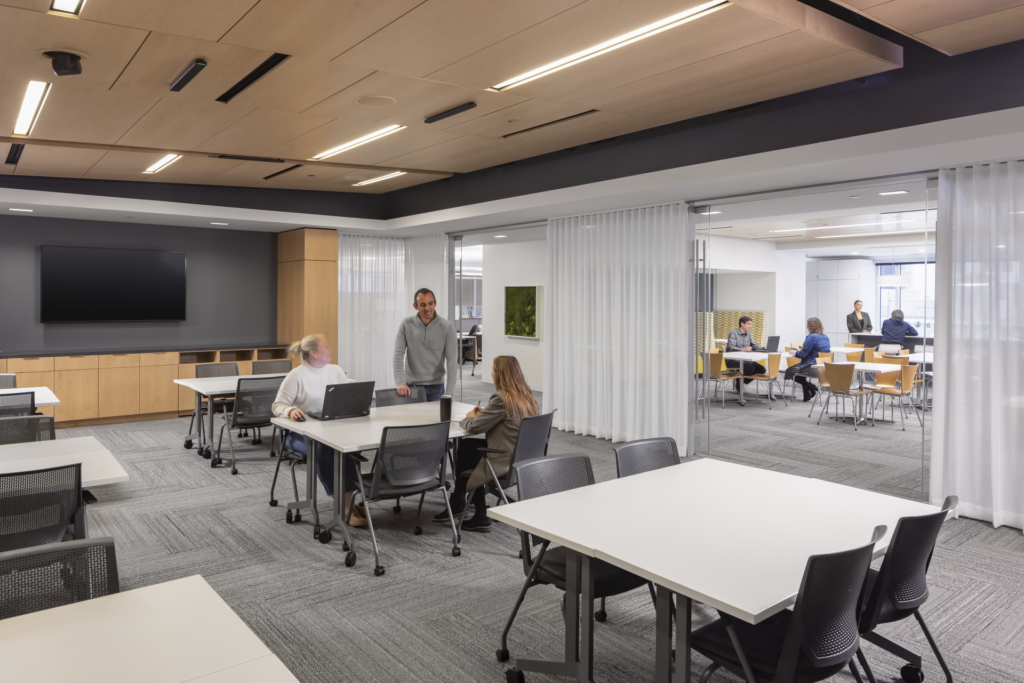Low workplace engagement is a challenge that business leaders and human resources professionals have grappled with for the last several years. According to Gallup, just 32% of U.S. employees report being engaged in their work—a number that was rising prior to the pandemic, but has since been on the decline. As the AEC industry, and our firm in particular, finds itself in a significant growth period, measuring engagement and employee experience is a key component to building a healthy, thriving culture. It’s a way of listening and taking actions that address systemic drivers that may be enabling inequities, low morale, work overload, unmanaged stress, and in some cases burnout.
For the last four years, BWBR has conducted an annual engagement survey to gain insights into our team’s attitudes, opinions, and outlooks on their careers and employee experiences, allowing us to act in areas where our staff may feel limited. Survey results have been consistently positive and useful indicators of how healthy our culture is growing. For example, our 2023 total engagement level hit a high of 82%, over 2.5 times the national average, and 98% of employees would recommend working at BWBR.
Engaged employees feel positive about their workplace—a win-win for both organizations and staff, as engaged teams are productive, innovative, loyal, and help a firm achieve its goals. However, surveys aren’t an all-encompassing solution for improving engagement. In fact, they’re only the first step to gaining the insights that allow our firm to take action to maintain a consistent positive employee experience.
Starting Strong and Being Curious
Even when asking the right questions and taking the right follow-up steps, engagement doesn’t occur without our staff feeling like they belong with purpose, meaning, and connection. This coupled with our clear mission and shared values helps sustain a supportive culture. At BWBR, this means giving workers the autonomy to work flexibly anywhere they choose, supporting professional and personal development, offering competitive wages, and providing skill-building for equity and mental health.
Still, our survey data gave us clues that there may be something else to consider. When we zeroed into groups and segments of our staff, the story changed—we realized overall engagement measures were just one piece of a bigger picture of data. We wondered whether employees could be engaged, yet not feel fulfilled. We flipped our thinking and asked: Who was not only giving energy to our culture by being engaged, but also getting energy from it in return? Our new goal is to use our data to inform not only engagement actions, but to inform how we can help more of our staff thrive.
Inspired by Microsoft’s efforts measuring employee thriving, we’ve implemented an approach that similarly utilizes our engagement data with four key components: people, pay, purpose, pride. We call this our “thrive index,” and we use it to measure how many employees are most likely energized by our culture. After all, shouldn’t a culture recharge as much as charge? At BWBR, we believe a sustainable healthy culture does this. At present, 60% of our staff are thriving, with an additional 28% nearly approaching thriving status.
Thriving Defined
Although BWBR’s goal of measuring thriving is still in very early stages, our mission continues to include deep commitment to the development of our staff. Our thrive index is measuring staff fulfilment based on these objectives:
People is defined by an overall sense of belonging at work, which inclusivity is a critical foundation for fostering, allowing employees to bring their most authentic selves to work. 98% of employees agreed that BWBR is an equitable workplace, and with equity integrated into our everyday business practices, we’ve seen attitudes like “my voice is heard” and “I belong at BWBR” rise to 87% and 93%. And even though our staff work from a variety of locations, 97% feel socially connected and say their teammates have their backs.
Pay is a component that is simple in definition, though absolutely critical to employee fulfilment. Of course, in order to thrive at work, employees must be paid adequately to maintain financial wellbeing. In 2023, 92% of employees reported feeling fairly compensated for their work.
Purpose stems from staff understanding the meaningful impacts of their work through contributions to society, clients, or the company. With purpose infused in day-to-day tasks, employees have increased motivation, job satisfaction, and pride—leading into the final component. At BWBR, 98% of staff say their work gives them meaning.
Pride, the fourth of the key components of thriving, comes from both individual work accomplishments and collective pride in the company. Employees highly recommending their company to others is a strong sign of fulfilment in this area, as well as feeling valued, which was reported by 89% of BWBR staff.
Next Steps
This is only the start of the ways we’re using data to inform how we’re building and sustaining our culture at BWBR. We see these numbers as strong, but we know we have room to improve. We want more staff to thrive, and we want more staff to get energy from their work.
Many factors are at play, one of which is the kind of people who work here and their commitment to our culture—it’s because of them that we’re so optimistic about the future. Our people have always been our firm’s most important asset. As Principal and People and Culture Director Tricia Eiswald says it, “Our people are everything—they power our designs and support our clients, so investing in them is one of the smartest and most important things we can do as a firm.”
With new ways to listen to and measure our employees’ experiences, we can grow our culture in ways that not only work for them and our clients, but that also help staff thrive for the long term.








